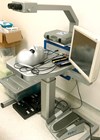Senior trainees supervising other more junior trainees’ cataract surgery is a skill which needs to be taught and developed with care. It is beneficial for senior trainees as it provides an opportunity to develop supervision techniques prior to consultancy and can enhance their own surgical learning. Appropriate standards and optimal outcomes must be maintained, and the ideal setting of supervision should be considered.
In this article, we discuss some important considerations to bear in mind before supervising surgery performed by more junior colleagues.
We know from National Ophthalmology Database (NOD) cataract data that junior surgeons have higher complication rates during cataract surgery [1]. Cataract surgery can be an unforgiving operation, where precision with each step helps to increase the chances of a successful procedure. Excellent national outcomes have been reported, and patient expectations are high. It has been documented that trainee outcomes are significantly less successful than those of consultants, which is to be expected given the steep learning curve of the skills involved [2]. There are many methods available for the trainee to practise each step of the cataract operation successfully prior to initiating surgery on a patient. Supervision of these methods enhances learning and produces a safer operation, at the right time, for the patient and trainee.
Modern ophthalmic training should involve multiple strategies to help trainees to learn cataract surgery. The Royal College of Ophthalmologists (RCOphth) microsurgical skills course often provides the foundations required to then proceed with learning via both simulated and real-life settings. Various simulation techniques are available that can be used to improve specific aspects of cataract surgery, along with other surgical skills also. Simulated surgery can be used to improve certain surgical steps, such as the capsulorrhexis [3] as well as over-all complication rates [4]. Other authors report the improved confidence of junior surgeons after undertaking simulation [5], which is surely beneficial prior to operating on patients.
The Royal College of Ophthalmologists has supported simulated surgery throughout surgical learning at all levels. They recommend documenting this type of learning in log books and including if this was performed under supervision or not. Senior input and review of techniques during simulated learning is also important to avoid repetition and learning of poor techniques. It is also useful for more experienced surgeons to refresh skills and keep their skills up to date. Various options are available for simulation, including pigs eyes / cadaver material / model eyes, as well as low fidelity options such as grape skin / cellophane wrap to practise the capsulorrhexis and the virtual simulator. The College has a simulator that can be pre-booked for sessional use [6].
The RCOphth curriculum [7] now expects trainees to manage their own operating list and supervise junior trainees prior to completion of training, with new curriculum assessments targeting these skills. This is a useful exercise, as it allows trainees to start developing supervision skills whilst still in training and on operating lists with the support of a consultant if required. This should hopefully make the evolution from senior trainee to consultant more seamless.
The transition from being supervised to supervising others can be strange and daunting for trainees. We have compiled a list of tips that can be considered by trainees prior to commencing the supervision of more junior trainees.
Top ten tips for senior trainees supervising junior trainees in cataract surgery:
1 Awareness of prior experience is vital to be able to tailor cases to the level of trainee’s surgical experience. A preoperative risk stratified system helps to decide which cases are suitable for the trainee’s level, although it is always wise to check the patient yourself at the slit-lamp also.
2 Suggest having a code word for stopping surgery; especially useful if patient is a local case. Be conscious of the language used during surgery, especially if the patient is awake: try not to use words that may alarm the patient. Even words used commonly such as chop or cut etc. may alarm some patients.
3 Communication is key and needs to be considered prior to starting a case; what you mean to say can come across very different to someone else. Statements need to be expressed explicitly whilst in a calm way. This can be rehearsed prior to the session with some consideration given to the events which may occur on the day.
4 Try and break down what you want to say into small structured steps, as you may not be aware of prior experience or ability to manage complex cases. Also, it is important to be aware that most patients are awake and you do not want to cause any unnecessary anxiety.

Figure 1.

Figure 2.
5 Decide whether scrubbing is required or if you can supervise through a teaching microscope. This will depend on how familiar you are with the trainee’s experience and their capability. It may be worthwhile considering watching the trainee on an Eyesi simulator (Figures 1 and 2) prior to the session, if this is available in the department.
6 Identify steps that the trainee would like to improve on prior to starting cases. Supervised simulation can be very helpful here before going live on a patient. Consider the various methods of simulation available depending on the step being considered.
7 Go back to complete basics: ensure optimal positioning of the patient and adequate draping as this may create more difficulties later on in the case if not done adequately.
8 Try to manage confidence levels: be prepared to take over if necessary but give the trainee time to undertake the case: this often requires efficient use of theatre time. If the consultant can complete some cases at the beginning of the list it can create more time for educational opportunities towards the end of the list. If sufficient time is allowed to complete a whole case with a trainee, it starts a cycle of boosting surgical case numbers and ultimately confidence. Engage the trainee with this decision-making so they are fully aware of the plan. This helps ease any pre-existing anxiety. It may even allow the trainee time to go and practise with various simulation techniques such as the Eyesi machine prior to undertaking the case.
9 Watch every step initially and take notes so that feedback on minor issues can be given at the end of the case whilst major issues can be raised during surgery. Various feedback techniques are available such as the sandwich technique, where praise is given either side of constructive criticism. Simulation can also be used to improve communication and feedback techniques.
10 Ensure the whole theatre team is aware of the plan. The consultant should be readily available to address any concerns / problems which are encountered, even if not present in the operating theatre.
Stress reduction during cataract surgery
Unfortunately there is no easy answer to reducing stress. However, It is important to recognise that training any member of the team can be stressful, especially in the initial stages.
Being aware of this can itself be helpful to both parties, especially with the tone of voice used in the theatre.
Ways to reduce the stress could include discussing surgical steps with the trainee beforehand and actually seeing them in action with a consultant prior to you commencing further training.
The Eyesi may also be helpful here to reduce stress levels.
References
1. Narendran N, Jaycock P, Johnston RL, et al. The Cataract National Dataset electronic multicentre audit of 55,567 operations: risk stratification for posterior capsule rupture and vitreous loss. Eye (Lond) 2009;23(1):31-7.
2. Sparrow JM, Taylor H, Qureshi K, et al. The Cataract National Dataset electronic multi-centre audit of 55,567 operations: risk indicators for monocular visual acuity outcomes. Eye (Lond) 2012;26(6):821-6.
3. McCannel CA, Reed DC, Goldman DR. Ophthalmic surgery simulator training improves resident performance of capsulorhexis in the operating room. Ophthalmology 2013;120(12):2456-61.
4. Staropoli PC, Gregori NZ, Junk AK, et al. Surgical simulation training reduces intraoperative cataract surgery complications among residents. Simul Healthc 2018;13(1):11-5.
5. Ng DS, Sun Z, Young AL, et al. Impact of virtual reality simulation on learning barriers of phacoemulsification perceived by residents. Clin Ophthalmol 2018;12:885-93.
6. The Royal College of Ophthalmologists: Simulation in Training
https://www.rcophth.ac.uk/
training/ost-information/simulation/
Last accessed April 2019.
7. The Royal College of Ophthalmologists Training Curriculum.
https://www.rcophth.ac.uk/
curriculum/ost/summary/
Last accessed April 2019.
COMMENTS ARE WELCOME









